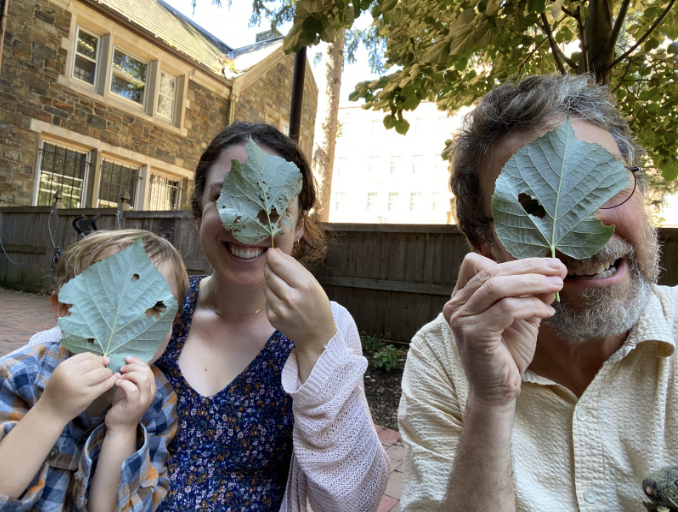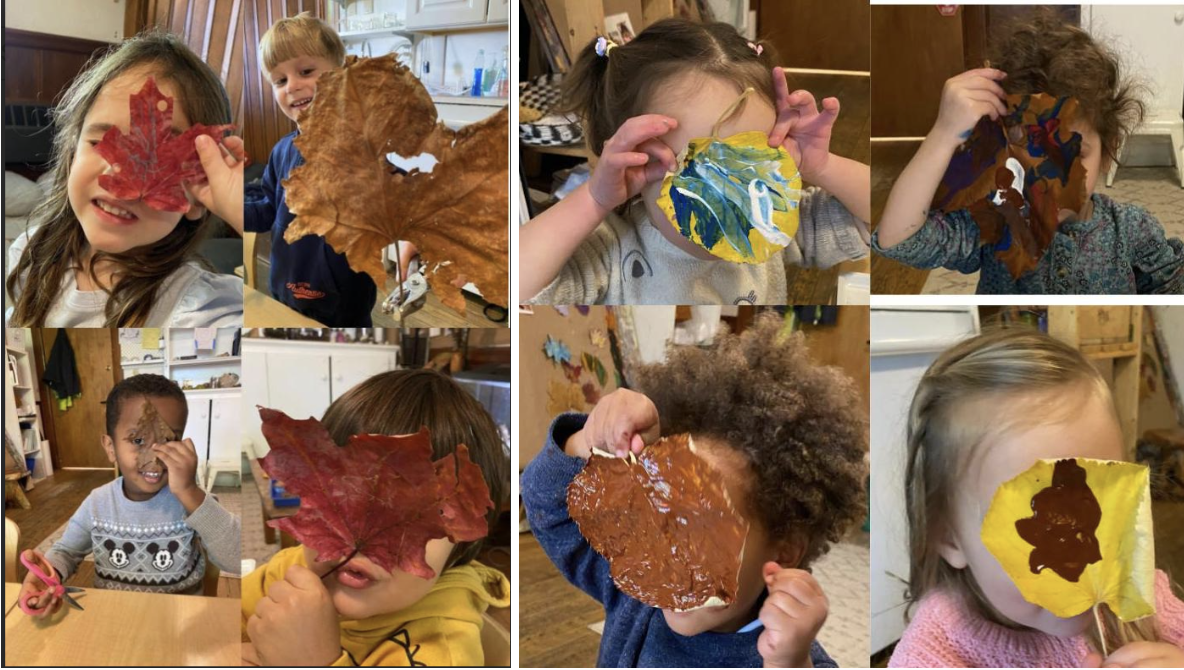The Leaf People: An Exercise in Collective Imagination

This essay documents the initial part of an inquiry into “Leaf People", sharing what I am learning about facilitating a process of collective imagination by a group of children.
Meet the Leaf People
The Leaf People are not real. They are imaginary. They put leaves on their faces and the magic wind can blow them up into the air. Leaf People like giving and getting gifts. Sometimes they go fishing.
So begins The Leaf People Meet the Pandas, the fourth in a series of books written and illustrated by the Green Dragonflies (the children in the five-year-old classroom at Newtowne).
Leaf People have popped up across Newtowne. Through drawings, dramatic play, dance parties, and storytelling, children across all four classrooms of our school are collectively imagining who the Leaf People are and what they do.
This essay tells of the genesis of the Leaf People, shares documentation from the initial months of inquiry, and explains what I am learning from my efforts to help a group of children imagine together.
Collective Imagination
The anthropologist and social activist David Graeber wrote, "The ultimate hidden truth of the world is that it is something that we make, and could just as easily make differently." Humanity needs to make our world differently; to create social structures that are ecologically sustainable and just. To do this together, we need to imagine new economic, political, and social organizations.
Stories are a vehicle we can use to imagine. Ursula Le Guin’s Always Coming Home is an excellent example of what science fiction writers call world building and post-humanist thinkers call speculative fiction. The book tells of the fictional Kesh People who live in the future and have a sustainable relationship with the rest of the natural world. In an impressive display of world building, Le Guin includes accounts of the Kesh’s food, games, festivals, education, and economics. There are Kesh poems and stories, and even a companion album of their music, created in collaboration with composer Todd Barton.
What if we playfully imagined worlds together? The task of conceiving a sustainable future is not a solo endeavor; the effort is too big for a single mind. Indeed, recent events confirm the danger of one person – even one with a moral compass – dictating the direction of a society. What I am calling for are collective stories. The Leaf People are an opportunity for the children of Newtowne to tell a story together; an exercise in collective imagination.
The Genesis of the Leaf People
The Leaf People originated at the start of the last school year. Three-year-old Benj, who, at the time, had little English and much Portuguese, was missing his parents. His teacher Danielle and I, who had little Portuguese and much English, were trying to console him. Μy suggestion to take him outside had no immediate effect. On a whim, I plucked three leaves with holes in them from a tree, put one in front of my face, and offered the others to Danielle and Benj. The impact was remarkable – the crying stopped and Benj smiled.
Soon other children and their families were getting into the act. The Leaf People were born.
Interest in the Leaf People faded as the leaves fell from the trees and we moved on to other topics.
Last June, I was reflecting on my first year at Newtowne with our director Caitlin Malloy. She appreciated some of the practices I had begun, including the Critter Count and Critter of the Month, and wondered about expanding our focus to include the plants and trees in our city.
With Caitlin’s comment in mind, I brought the Leaf People back this year to draw attention to trees. I invited children in all the classrooms to decorate leaves and become Leaf People.

I assumed the project would – like the previous year – end when the leaves started to disappear for the winter.
Leaning into the Leaf People
But then the November United States elections happened. As someone who believes that political discourse should be civil and truthful, it was not a happy day.
I thought about the Leaf People. I had decided that they were kind, inclusive, and had adventures. But beyond that, the Leaf People were a blank canvas; an opportunity for the children to imagine together. So I decided to continue with the Leaf People and see if the topic would engage the children and my colleagues, at a time when it felt like so many of us were yearning for ways to support kindness and inclusivity.
Imagining the Leaf People
The children have imagined a lot about the Leaf People. When someone imagines something about the Leaf People, I put the idea (along with their photo) on a poster in the studio. The poster serves as a depository of our findings – our common body of knowledge about the Leaf People.
Through play, drawing and storytelling, the children have decided that leaf people:
- eat cookies, ice cream and donuts among other foods.
- participate in many activities, including hide and seek, camping, and dance parties.
- live in the forest and use solar panels to get their electricity.
- have many friends, including Leaf Aliens, Rabbits, and Pandas.
Pandas? To help children think about the Leaf People, I took them to what we call the Secret Forest, a space behind our school that has some bamboo. The children decided if there was bamboo, there must be Pandas, leading to the fourth Green Dragonfly Leaf People book.
The Leaf People Meet the Pandas
The Leaf People Meet the Pandas was written by successive groups of Green Dragonflies over four days of visits to the Secret Forest during their Studio time. Each group heard the chapters told by their classmates and added to the story. The children then illustrated the book. I titled the chapters; all the other words are the children’s.
In Chapter 1, the Dragonflies raise an interesting question: What happens when two groups meet? The chapter begins:
Once upon a time there were three Leaf People. And then one day they said, “Is it true the Pandas can get used to the Leaf People?” Leaf Person Maverick said, “The race car rainbow could come up and take the Pandas away.”
At first, there is apprehension:
And then the Pandas scared the Leaf People. And then the Pandas slide down the rainbow. Then they went back and decided to be nice but Leaf People were afraid. But the Pandas didn't know and picked them up. And the Leaf People were afraid they would cover them in sand. But they did not cover them. They had to drink orange juice because the Leaf People were sick. But the Pandas put the Leaf People in a cage. Then the Pandas said, “Do you want to try some bamboo?” to the Leaf People. The Leaf People said, “No thanks.”
The chapter ends with a opening for a connection between the two groups:
And then the Leaf People asked, “What is your name?” And the Panda said, “Our name is Keepy People and Deepal.”
This opening is realized by the children who work on Chapters 2 and 3. Chapter 2 notes how food can bring groups together:
Sometimes the Pandas eat donuts. And sometimes they eat strawberries and ice cream. When it is cold they drink hot chocolate. They share with the Leaf People because they are nice. Because they eat and shared food they became friends. And the Leaf People weren’t scared. There was a dance party and they played drums.
Chapter 3 explains how play can bring groups together:
The Pandas did not eat the Leaf People. The Pandas and the Leaf People became best friends and played baseball and soccer and basketball. And then they had a big party and the Pandas married the Leaf People. So the Leaf People went to their house and had dinner together. And for dessert they had a big cake– Panda Bamboo Cake. They built a fence around their house so no one could get them.
Of course, the Leaf People were at risk of being eaten by Pandas; Pandas eat leaves. And it makes sense that the two groups were wary of each other at the start; they were just meeting. But the Dragonflies offer a very different and positive conclusion to what often is taken as inevitable when two groups meet. Rather than conflict, the Leaf People and the Pandas become friends.
Lessons in Collective Imagination through Stories
Historically, I have not been a fan of collective stories. Both as a facilitator and participant, I have found the process of a group of people trying to construct a story together frustrating. More often than not, someone would take the narrative on a tangent, rendering it incoherent.
This has not been the case with the Leaf People stories. In The Leaf People Meet the Pandas, the children build off one another's ideas. For example, the children who told Chapters 2 and 3 provide a resolution to the issue of the two groups’ initial apprehension about each other.
Full transparency: I provide light editing to the Leaf People stories involving naming chapters, breaking different ideas into paragraphs, and pagination. I remained true to the children's words. This sometimes leads to seeming non sequiturs – for example, the Leaf Peoples’ need to drink orange juice. Yet overall, the narratives in all the books have coherent storylines.
I suspect the common focus on Leaf People, including having a common body of knowledge about them, provided the children guardrails that led to cohesive stories. I have more to learn about this process. What provides a process of collective imagination coherence? How do I navigate the tension between individuals having the freedom to play with ideas and the group staying true to a theme? The questions of future investigations.
The reactions of other children at Newtowne to the Green Dragonflies’ stories is an indicator of their success. When I read the Leaf People books to the Blue Otters (four-year-olds) and Purple Fish (three-year-olds), they hang on every word. I loaned one of the books to the Purple Fish for a week. When I took it back,the children clammered for its return.
After publishing the first Leaf People book (A Leaf People Story), it was the Green Dragonflies, and Josh in particular, who drove additions to the series. It seemed every time I stopped by in the classroom, Josh would ask when we would be making another book. His friends were happy to participate with him in the book's creation. On Josh's behest, there has been a fifth (Mail in the Secret Forest) and a sixth (Ice Cream People and The Leaf People) entry into the series.
An important note. As LeGuin shows in Always Coming Home, sharing multiple artifacts about an imagined world enriches understanding of that world. More than in a traditional novel, she includes poems, drawings, music and more. The process of collecting imagination can involve the “hundred languages of children.”
Who are your Leaf People?
“Who are our Leaf People?” is a question that I hope other teachers will ask – about whom can our children collectively imagine? Providing children a chance to imagine can allow them to consider what to do if others need help, propose solutions to community problems, and think through positive outcomes when two groups meet.
My thanks to Amos Blanton and Caitlin Malloy whose feedback helped me explain the Leaf People project. I am puzzling over what to call the phenomenon described here. Collective Imagination is close and I wonder if there is a better term. If you have a thought, please let me know at benmar89@mit.edu.
